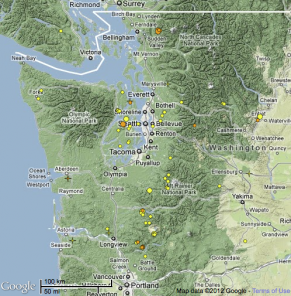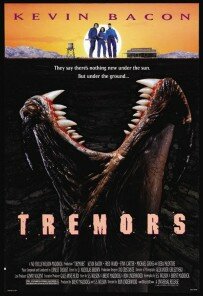The Pacific Northwest Has Got the “Tiny Quake” Shakes

Image from Pacific Northwest Seismic Network, using Google Maps
Remember our “Two Tiny Quakes” post two weeks ago? Maybe you thought things had quieted down, but actually we just couldn’t keep up.
As KING TV’s Glenn Farley reports (“Swarm of mini earthquakes recorded throughout W. Washington“), this week has been especially active in Western Washington, with six quakes Tuesday, fourteen Wednesday, and eleven on Thursday.
To date, our portion of the Pacific Rim’s Ring of Fire is merely feeling peptic: Some of these quakes are truly tiny, 0.2 and 0.4 magnitude on the Richter scale. But a 2.4 hit near Woodburn, Oregon, a little after 5 a.m. this morning, and quakes in that range have not been uncommon in the spate of recent incidents.
Most are relatively shallow, six to twelve miles down, but one, a 1.8 on April 18 near Skykomish, was 60 miles deep. That’s deep down in the subduction zone, where the Juan de Fuca plate is being smooshed beneath the North American plate.
What it all means is anyone’s best guess. It could be relatively trivial “jostling” between the plates. Or it might not be trivial. (In contrast, not much is going on at all with our slow-motion tremors, except for some activity near the southern tip, near Redding, California.) More research, as they say, is needed.
UPDATE: The Pacific Northwest Seismic Network’s John Vidale says, “I think it is mostly that we are looking more closely with our new software, and seeing a larger fraction of the small earthquakes that were always happening.” He’s also not sure that tiny quakes were being plotted on their map, previously, which is probably smart, as seeing so many of them alarms the easily alarmable.

Alternate theory
To give you an idea of how much more research, Oregon Public Broadcasting is just reporting on the discovery of “two previously unknown earthquake faults–and possibly a third–near Bellingham, Washington.” That’s the sort of thing people like to know, if their house is sitting of top of a fault or not. Here in Seattle, SoDo is the site of new liquefaction research. (What’s liquefaction?) Paul Bodin describes the “liquefaction array”:
The array consists of accelerometers to measure the 3D shaking at the surface and at 5, 45, and 56 meters deep, and piezometers at 7, 23, 29, 42, 47 and 52 meters deep, as well as a surface barometer needed to “correct” the buried piezometer data. We can observe the shaking levels at these depths, and calculate the strains in the ground between them, as well as monitoring the ground-water pressure changes that cause the liquefaction.
Once again, Glenn Farley is on the job, discussing how, even in the absence of major quakes, the array is picking up information from heavy freight trains that send vibrations deep into the earth. It’s cheap seismography, letting scientists peer into the ground beneath our feet and map its behavior.

 Daily Email Digest of The SunBreak
Daily Email Digest of The SunBreak